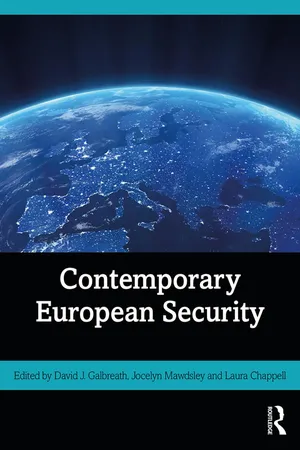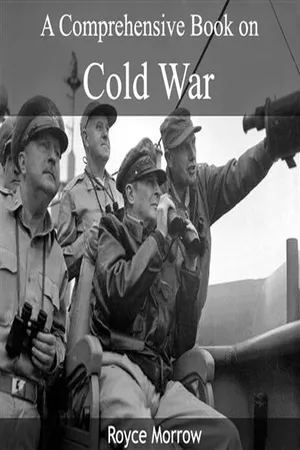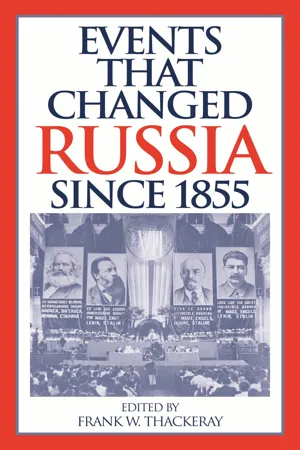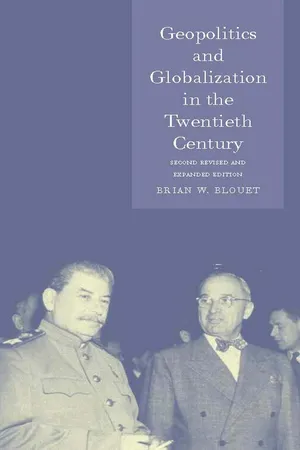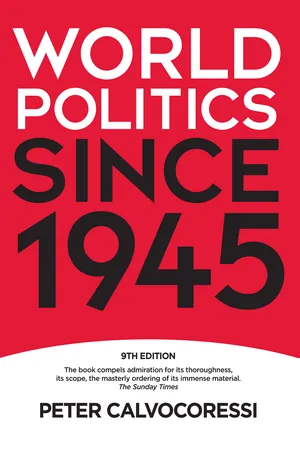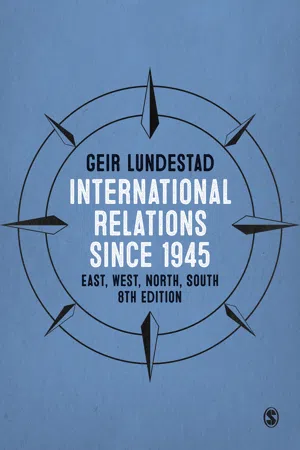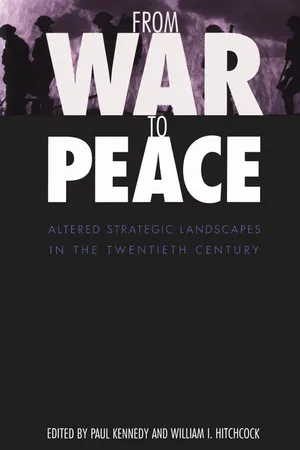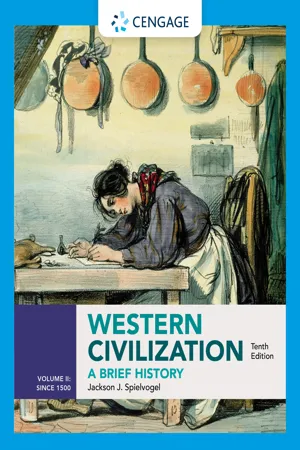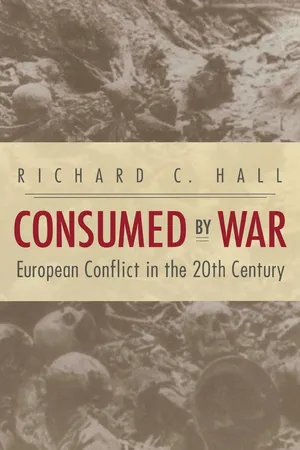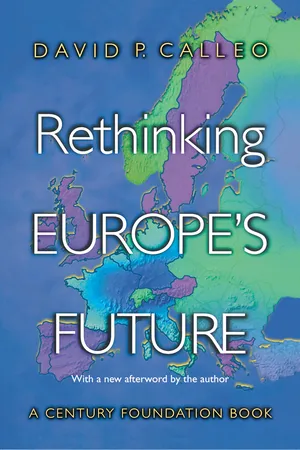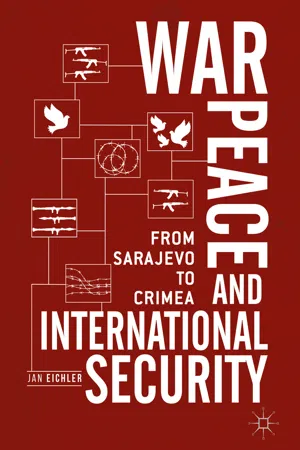History
Cold War in Europe
The Cold War in Europe refers to the geopolitical and ideological struggle between the Western bloc, led by the United States and its NATO allies, and the Eastern bloc, led by the Soviet Union and its Warsaw Pact allies, following World War II. This conflict was characterized by political tension, military build-up, and proxy wars, and it shaped the division of Europe into capitalist and communist spheres of influence until the collapse of the Soviet Union in 1991.
Written by Perlego with AI-assistance
Related key terms
1 of 5
11 Key excerpts on "Cold War in Europe"
- eBook - PDF
- David J. Galbreath, Jocelyn Mawdsley, Laura Chappell(Authors)
- 2019(Publication Date)
- Routledge(Publisher)
These developments institutional- ised the security arrangements that would prevail until the end of the Cold War and solidified the division of Europe. From Cold War to European peace 19 Europe and the Cold War For many Europeans, after the demarcation lines between East and West had been settled, the Cold War was a remarkably stable period, particularly in comparison with what had gone before. Once the Soviet Union had acquired an atomic bomb in 1949, the potential for outright war between the two sides receded, as it would have meant mutually assured destruction (MAD). Berlin had the potential to be a flashpoint, but after the construction of the Berlin Wall in 1961, when the city’s division was made concrete, that danger faded. As Judt (2005) argued, the experience of the Cold War as a European was different to the experience of a Soviet or American citizen. Europeans, whether on the East or West of the Iron Curtain, understood that they could do little to influence either the United States Figure 2.1 Cold War military alliances Source: Wikimedia Commons (2006), ‘Cold War Europe military alliances map’, Available at: https://commons. wikimedia.org/wiki/File:Cold_war_europe_military_alliances_map_en.png (accessed: 19 January 2019). 20 Laura Chappell and Jocelyn Mawdsley or the Soviet Union, and so, despite Europe being the expected battleground if the Cold War turned hot, and where many of the nuclear weapons were targeted, it was a largely passive experience. For the Warsaw Pact states, their impotence vis-à-vis the Soviet Union was made very clear early on. The 1956 Hungarian Uprising was quickly put down by Soviet troops, and the reformist government of Imre Nagy replaced. A period of liberalisation in Czechoslovakia under Alexander Dubček in 1968, known as the Prague Spring, was also quickly and brutally put down by the invasion of Soviet and other Warsaw Pact troops. - No longer available |Learn more
- (Author)
- 2014(Publication Date)
- Learning Press(Publisher)
Eastern Bloc events Cold War map of Eastern Bloc, western-aligned and other countries in Europe ______________________________ WORLD TECHNOLOGIES ______________________________ As the Cold War became an accepted element of the international system, the battlegrounds of the earlier period began to stabilize. A de facto buffer zone between the two camps was set up in Central Europe. In the south, Yugoslavia became heavily allied to the other European communist states. Meanwhile, Austria had become neutral. 1953 East Germany uprising Following large numbers of East Germans traveled west through the only loophole left in the Eastern Bloc emigration restrictions, the Berlin sector border, the East German government then raised norms -- the amount each worker was required to produce—by 10%. Already disaffected East Germans, who could see the relative economic successes of West Germany within Berlin, became enraged, provoking large street demonstrations and strikes. A major emergency was declared and the Soviet Red Army intervened. Creation of the Warsaw Pact In 1955, the Warsaw Pact was formed partly in response to NATO's inclusion of West Germany and partly because the Soviets needed an excuse to retain Red Army units in potentially problematic Hungary. For 35 years, the Pact perpetuated the Stalinist concept of Soviet national security based on imperial expansion and control over satellite regimes in Eastern Europe. Through its institutional structures, the Pact also compensated in part for the absence of Joseph Stalin's personal leadership, which had manifested itself since his death in 1953. While Europe remained a central concern for both sides throughout the Cold War, by the end of the 1950s the situation was frozen. Alliance obligations and the concentration of forces in the region meant that any incident could potentially lead to an all-out war, and both sides thus worked to maintain the status quo. - eBook - PDF
- Frank W. Thackeray(Author)
- 2007(Publication Date)
- Greenwood(Publisher)
Over the next 45 years, the early confrontations deepened into a global struggle between East and West. The Cold War came and went in stages, with each period marked by intricate foreign policy engagements between the two superpowers and their respective allies. But when one surveys the full sweep of confrontation between the United States and the Soviet Union, the observer is struck by the overriding sense that this long era was, in fact, far more dangerous for the interests and survival of the Soviet Union than for the United States. It proved to be the final crisis of the 70-year Soviet experiment, culminating in the collapse of the Soviet political, ideological, and economic system in 1991. Furthermore, by providing the catalyst for the Soviet Union’s implo- sion, the Cold War brought to an end centuries of Russian autocracy and empire and ushered in a difficult transition to democracy. From the perspective of Russian domestic and foreign policy, the Cold War can be divided for useful discussion into four distinct periods: the era of Stalinist imperial expansion and virulent ideological orthodoxy (1945–1953), peaceful coexistence and ideological revision (1953–1962), détente (1962–1979), and atrophy and ideological rejection (1980–1991). Each of these periods had its unique East–West policy confrontations and broader implications for international affairs. Each era was produced in significant part by internal Soviet politics, and each era in turn dramatically affected the Soviet state, ideology, and economy. Finally, these segments of the Cold War, to the extent that they were the out- comes of Soviet foreign policy, reflected the continuing strains between Marxist-Leninist ideology, which served as the legitimizing authority for Communist Party rule, and Soviet national interests. - Brian Blouet(Author)
- 2004(Publication Date)
- Reaktion Books(Publisher)
seven The Cold War and the Triumph of Geopolitics American leaders in the Second World War, Roosevelt and Cordell Hull, thought that there would be no need for alliances and spheres of influence when the war ended. However, having been forced to support a totalitarian empire – the Soviet Union – against the totalitarian empire of Nazi Germany, the leaders were wrong to think that geopolitics would end with the war. The seeds of the Cold War sprouted on Midsummer’s Night, 1941 , as the Axis attacked the USSR and the US moved to sup-port Stalin and his regime. As the war ended the ‘strategic space of geopolitics became . . . global’. 1 Quickly the postwar world was divided into blocs: a Western bloc led by the United States and a communist bloc dominated by the Soviet Union in Europe and by China in East Asia. The blocs were ready for war. NATO, established in 1949 , provided for the defence of Western Europe and North America. The Warsaw pact ( 1955 ) was formed as a result of German rearmament which had been a response to the Korean War, as American Pacific demands increased and she needed more help in Europe. Communist China wanted to attack Taiwan but was deterred by the US Pacific fleet. The blocs competed for global influence. The West pro-moted democratic political systems but was prepared to ally with dictators so long as they proclaimed anti-communism. The Soviet Union tried to export its economic model to Latin America, Africa and Asia. The Chinese were less influential but converted some countries, including Albania, to their brand of communism. In every continent civil wars were fought between communists and Western-aided groups for control of countries and political systems. Among the most visible of the wars were conflicts in El Salvador, Nicaragua, Angola and Vietnam. 133- eBook - PDF
- Peter Calvocoressi(Author)
- 2013(Publication Date)
- Routledge(Publisher)
Seen from Moscow, the western world was inspired by capitalist values which demanded the destruction of the USSR and the extirpation of communism by any means available, but above all by force or the threat of irresistible force. Both these appreciations were absurd. When the Second World War ended the USSR was incapable of further military exertion, while the communist parties beyond its immediate sphere were unable to achieve anything of significance. The western powers, while profoundly mistrustful of the USSR and hostile to its system and beliefs, had no intention of attacking it and were not even prepared to disturb the dominance of central and eastern Europe secured by its armies in the last years of the war. Each side armed itself to win a war which it expected the other to begin but for which it had no stomach. 4 THE COLD WAR The focus of the Cold War was Germany, where confrontation over Berlin in 1948–49 came close to armed conflict but ended in victory for the western side without a military engagement. This controlled trial of strength stabilized Europe, which became the world’s most stable area for several decades, but hostilities were almost simultane- ously carried into Asia, beginning with the triumph of communism in China and war in Korea. These events led in turn to an acceleration of the independence and rearma- ment of West Germany within a new Euro-American alliance and to a succession of conflicts in Asia, of which the Vietnam War was the most devastating. At no point did the protagonists directly engage each other but both sought to extend their influence and win territorial advantage in adjacent parts of the world, notably the Middle East and – after its decolonization – Africa. - eBook - ePub
International Relations since 1945
East, West, North, South
- Geir Lundestad(Author)
- 2017(Publication Date)
- SAGE Publications Ltd(Publisher)
2 The Cold War in Europe, 1945–1949Political Science and History
In political science the study of international relations has been dominated by two basic general approaches, realism and liberalism. Realism was long the dominant approach. Its starting point was the anarchic nature of the international system, in the sense that the predominant consideration of each state was to protect its own security. You could never be certain what other states would do in the future. Therefore you had to prepare for the worst contingencies. In a world of sovereign states, international institutions mattered only on the margins. The international community differs from the domestic situation within individual nations in that there is no effective central power having more or less a monopoly of the use of force.No state was really willing to leave its primary security requirement to an international authority. The United Nations could perform some useful functions, but the Great Powers all insisted on having a veto to stop the new organization from undertaking actions contrary to their interests. The Soviet Union came to use its veto quite frequently. Since the Western powers dominated the UN, they long had less of a need to use their vetos.Conflicts are therefore inevitable in the international system. The normal state is rivalry rather than cooperation. Of course major powers can cooperate, but when they do so it is most often to face a joint threat. When the threat no longer exists, cooperation normally dissipates. In this perspective the antagonism between East and West is a new variation on a familiar theme. The coalition between the United States, the Soviet Union, and the United Kingdom was dissolved after Germany and Japan were defeated in 1945. A similar situation pertained after the Napoleonic wars and after the First World War. But the objection can be raised that the tension between East and West after the Second World War reached a higher level than after earlier, corresponding conflicts. - eBook - PDF
- Norman Housley(Author)
- 2000(Publication Date)
- Yale University Press(Publisher)
8 The United States, the Cold War, and the Post-Cold War Order Philip Zelikow It is impossible to analyze the settlement of the Cold War without comprehending what was being settled. In other words, a theory of settlement must be accompanied by a theory of what the Cold War was about. The Cold War can best be understood as the final phase, lasting nearly half a century, of a long global struggle between two fundamentally different conceptions for the organization and governance of modern society. That struggle began as the international system of the nine-teenth century was coming to its end in the bloody chaos of World War I. 1 Out of those ruins arose a new conception of gov-ernment and society, one that had not held power anywhere be-fore the war, and was offered as the ultimate response both to the industrial revolution and to the modern requirements for toted war. This form of governance claimed unlimited power over its subjects in order to transcend the traditional divisions of society and unite them in pursuit of Utopian ideals. These ideals differed, principally between a focus on a global conflict of nations and races or a global struggle of social classes. But all these varieties 159 Philip Zelikow 160 of totalitarianism were united in their hostility, even revulsion, toward the liberal democracies. Once the Bolshevik regime had survived the trials of civil war in Russia and the fascist dictator-ships also began attaining power, first in Italy, the battle lines were drawn around the world. By early 1941 the totalitarian states held most of the world's military power. But then the two most powerful states in the world, Germany and the Soviet Union, went to war against each other. The Cold War Becomes Evident, 1943-1946 The Cold War began as the outcome of World War n was coming into view. - eBook - PDF
Western Civilization
A Brief History, Volume II since 1500
- Jackson Spielvogel(Author)
- 2019(Publication Date)
- Cengage Learning EMEA(Publisher)
Chapter Outline and Focus Questions 28-1 Development of the Cold War Q Why were the United States and the Soviet Union suspicious of each other after World War II, and what events between 1945 and 1949 heightened the tensions between the two nations? How and why did the Cold War become a global affair after 1949? 28-2 Europe and the World: Decolonization Q Why and how did the European colonies in Africa, the Middle East, and Asia gain independence between 1945 and 1965? 28-3 Recovery and Renewal in Europe Q What were the main developments in the Soviet Union, eastern Europe, and western Europe between 1945 and 1965? 28-4 The United States and Canada: A New Era Q What were the main political developments in North America between 1945 and 1965? 28-5 Postwar Society and Culture in the Western World Q What major changes occurred in Western society and culture between 1945 and 1965? THE END OF WORLD WAR II IN EUROPE was met with great joy. One visitor to Moscow reported, “I looked out of the window [at 2 A.M.], almost everywhere there were lights in the window—people were staying awake. Everyone embraced everyone else, someone sobbed aloud.” But after the victory parades and celebrations, Europeans awoke to a devastating realization: their civilization was in ruins. Some wondered if Europe would ever regain its former prosperity and importance. Winston Churchill wrote, “What is Europe now? A rubble heap, a charnel house, a breeding ground of pestilence and hate.” There was ample reason for his pessimism. Forty million people (both soldiers and civilians) had been killed during the last six years. Massive air raids and artillery bombardments had reduced many of the great cities of Europe to heaps of rubble. An American general described Berlin: “Wherever we looked we saw desolation. It was like a city of the dead. Suffering and shock were visible in every face. - eBook - PDF
Consumed by War
European Conflict in the 20th Century
- Richard C. Hall(Author)
- 2014(Publication Date)
- The University Press of Kentucky(Publisher)
He stated that an "Iron Curtain" extending from Stettin in the Baltic Sea to Trieste in the Adriatic divided Europe into two hostile camps. The term stuck as a way to describe the physical as well as psychological division of Europe that endured for the next forty-five years. The establishment of Soviet power in eastern Europe evoked a serious but belated response from the Americans. Anxious to strengthen the gov- ernments in the American zone of western Europe against a possible Red Army advance, as well as to prevent electoral success by the communist parties in France and Italy, the Americans instituted both a military and an economic response intended to contain the Soviets. Essentially, the Americans adopted a policy intended to confine the Soviet presence in Europe to those areas in the east that were already occupied by the Red Army and undergoing the process of Stalinization. This American policy became known as containment. An influential article appearing in the July 1947 issue of the journal Foreign Affairs embodied the clearest state- ment of this policy. It was written by American diplomat George F. Ken- nan (1904-2005), who had considerable experience in Soviet affairs, and published under the pseudonym "Mr. X." After 1947 the basic parameters of the United States' policy for Europe were established, and that policy would be followed throughout the Cold War. The military response, announced in a speech by President Truman on 12 March 1947, became known as the Truman Doctrine. This program offered American military aid to countries threatened by the Soviets. In Origins of the Cold War 201 particular, it was directed at Greece and Turkey. Both countries, cut off from western Europe, had come under Soviet pressure. After being expelled by the Germans in 1941, the British returned to Greece in 1944, bringing with them the Greek government in exile. - eBook - PDF
- David P. Calleo(Author)
- 2011(Publication Date)
- Princeton University Press(Publisher)
Within two to three years after Germany’s defeat, the Soviet Union had consolidated direct military and political power over the Baltic states, Poland, Czechoslovakia, an Eastern rump of Germany, and much of the Balkans. One variety of totalitarian occupation, the Nazi, had been followed by another, the Soviet. Many in the West refused to acknowledge Stalin’s appropriations. T H E T H R E E P O S T WA R S Y S T E M S : A N O V E RV I E W 99 And many also refused to believe that the Soviets had exhausted their appetite for conquest. The communist coup in Czechoslovakia and the Berlin blockade of 1948 finally prompted the North Atlantic Treaty of 1949. The Korean War in 1950 completed the establishment of an American military protectorate over most of Western Europe, as well as Greece and Turkey. America’s desire to reassure Europe was, of course, a key element in its prompt defense of South Korea. In 1955, the Soviets got around to formalizing their own sphere as the Warsaw Pact. By that time, Europe’s bipolar system was well established. Stalin’s militant hostility after the war came as a rude shock to American aspirations. It tore away a huge Eurasian chunk from the anticipated liberal world economy. The “loss” of China in 1949 was a further heavy blow for Americans and British alike. Ultimately, the communists also prevailed in Indochina and were powerful in several other Asian nations. In a number of Western countries, most critically in France and Italy, large and indigenous Communist Parties, receiv- ing Soviet support and susceptible to Soviet direction, waged an ideo- logical battle from within. The Messianic and totalitarian character of the Soviet regime encouraged the view that the Cold War was a bipo- lar global struggle between “capitalism” and “communism”—two ideologically based models for modern political, economic, social, and cultural life. - eBook - PDF
War, Peace and International Security
From Sarajevo to Crimea
- Jan Eichler(Author)
- 2016(Publication Date)
- Palgrave Macmillan(Publisher)
The USSR saw it as a starting point of the remilitarization of West Germany and a further strengthening of the military threat from the West. It viewed West Germany in the light of the tragic experiences of the Second World War and thought that it failed to comply with the post-war demilitarization and denazification course (Gaddis 1997). Therefore, on 14 May 1955, the Warsaw Pact was formed as a security community which was joined by the USSR, Albania (which broke away from the partnership in 1963), Bulgaria, Czechoslovakia, Hungary, East Germany, Poland and Romania. Some experts consider this date as “the formal start of the cold war” (Gaddis 1997). At the time of its creation, the Warsaw Pact had a total of 6,000,000 soldiers, 175 to 225 Soviet divisions and 80 divisions of the satellite states. In the first period, until 1961, the armed forces of the member states developed independently. In the second phase, they were consolidated and their weaponry was modernized (T-53 and T-55 tanks and MiG-21 and SU-7 jet aircraft), and they began to hold their first joint exercises (Mastny et al. 2005). 3.2.5 The Suez Crisis in 1956 At the very end of the phase of the relative nuclear monopoly of the USA, the Suez Crisis broke out. At the beginning, there was an announcement of the US Secretary of State John Foster Dulles that the USA was canceling its promise to help Egypt in the construction of a dam at Aswan. Egyptian President Nasser responded to the announcement with the nationalization of the Suez Canal. Within NATO, two different approaches to this mat- ter were adopted. The then US president, Dwight Eisenhower, wanted to THE COLD WAR 93 develop a primarily diplomatic and economic pressure on Egypt, but he did not want to take military action.
Index pages curate the most relevant extracts from our library of academic textbooks. They’ve been created using an in-house natural language model (NLM), each adding context and meaning to key research topics.
